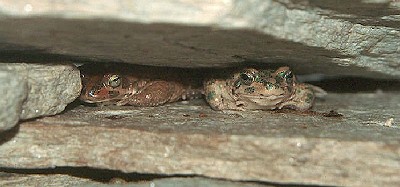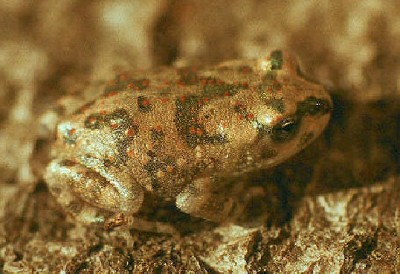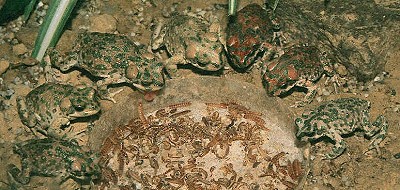| Bufo brongersmai (Brongersma´s Toad): Summary: A Report in the magazine Podarcis 3/2001, page 81-88, by Sergé Bogaerts <s.bogaerts@hetnet.nl>
The magazine Podarcis is available for download at
http://www.podarcis.nl,
download section: http://www.podarcis.nl/cgi-bin/toc.cgi?lang=eng, file type: .pdf You need to register for download at http://www.podarcis.nl/register/register_eng.html
In 2001 the magazine Podarcis 3/2001, page 81-88, contained a report
by Sergé Bogaerts about keeping and breeding of Bufo brongersmai.
Here is a summary of his report.
Keeping: Sergé Bogaerts toads originated from 2 sources: Mr. Laubner, Germany: Bufo brongersmai, white/tan dorsal coloration, probably from Sous Vally near Agadir, Western Morocco 3rd or 4th generation captive offspring Mr. Ralf Liebetrau, Germany: Bufo brongersmai, reddish-brown dorsal coloration, (always bigger than those with white/tan dorsal coloration) probably from somewhere near Terra Typica 2nd generation captive offspring The toads were kept in terraria of different sizes. Finally smaller terraria (30 x 40 cm, approx. 5 toads) turned out to be better suitable, as these were easier to inspect. The terrarium setup was as follows: One half of the terrarium was filled with flat rocks, which were stacked loosely with large holes in between and a bottom substarate of fine gravel. This section was lighted and heated localised by a 25 W reflector light. The other half of the terrarium had a loam bottom substrate and contained stacks of rocks as well as a small waterbasin which was cleaned and refilled every other day. This half of the terraria was not heated but sprayed with water once a week During the day temperature was approx. 25-30°C and at night roughly 15°C. Food consisted mainly of buffalo worms and small crickets dusted with a vitamin and calciumcarbonate mixture (Korvimin). Sergé Bogaerts indicates that under terrarium conditions the toads are often active during the day and may be found sitting fully exposed underneath the spotlight or between the rocks. They seemed to prefer the warmest locations. Once active the toads rapidly escaped between the rocks when disturbed.
Breeding:
According to Sergé Bogaerts male toads can be heared calling regulary during the winter
months and females then are already fat.
The toads get ready to breed without further action under year round conditions as mentioned above. His breeding advice: For breeding a separate terrarium filled with a water depth of about 5 cm and emerging rocks is used. The water during the day is heated to 25°C by an aquarium heater and 15°C at night (According to Mr. Liebetrau water temperature also may be as high as 30°C). Most part of the setup is covered to create a high relative humidity. Two males with good developped nuptial excrescences are placed in the terrarium. One or two days later a gravid looking female is added. Sergé Bogaerts usually leaves the female in for one week at the most. If no amplexus has taken place by then the female is returned and replaced by another female. If amplexus is taking place the second male is removed in order to minimise the stress on the pair. On 1st January 2000 Sergé Bogaerts started placing the toads in the breeding terrarium. On 14th January 2002 amplexus took place. On 16th January 2002 he raised water level by approx 2 cm and on 17th January 2002 he discovered the first clutch of eggs. 2 further pairs produced clutches on 18th January 2002. The eggs were placed in separate aquariums. Most successful was the clutch which hatched at a water temperature of 20°C (2 days after oviposition). At 15°C many eggs were infected by fungi and larvae died. Short after hatching the tadpoles were transferred to a large aquarium and the empty egg strands were removed as they decompose and rapidly contaminate water. According to Mr. Liebetrau it is best to maintain the tadpoles at 20-25°C, not to feed too much and to mostly feed the tadpoles with fish food (such as Tetramin), trout pellets, vegetable matters and occasionally some animal protein like frozen red moskito larvae. This proofed to be good advise. Sergé Bogaerts tested rearing the tadpoles in different groups under different conditions. Depending on temperature (10-28°C) the juvenile toads completed metamorphosis at a size of 8-12 mm after 24 - about 90 days (longer duration at lower temperatures). It turned out that the metamorphosing toadlets need enough suitable locations for crawling on land. Otherwise they drown. They start eating immediately after metamorphosis, even with the remainder of the tail still attached. Sergé remarks that the toadlets need lots of food and can be fed almost constantly. If they do not receive food in time they rapidly lose weight and become lethargic.
Sergé Bogaerts kept them in groups of 10-15 per terrarium (20 x 15 x 5 cm) decorated
with moist tissue and stacks of moist peat and bark.
The toadlets best developped if they were kept under drier conditions and at somewhat warmer temperatures (for example created with the aid of a light). The juveniles were fed with fruitflies and tiny crickets, later on also by curly-winged flies and buffalo worms. Daily fed toadlets measured 13-14 mm after a week, one month after metamorphosis the biggest already measured approx. 20 mm.
Remark:
I contacted Sergé Bogaerts for receiving additional information.
He really does not change keeping conditions througout the year.
In winter temperature automatically is somewhat cooler and humidity somewhat
higher without any action, but that time the toads already are ready to breed.
Conclusion: Bufo brongersmai is easy to breed, which is very uncommon for Bufo species. |
||||



